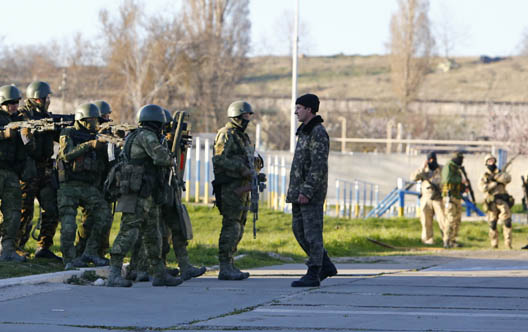
As Kyiv Asks Citizens to Donate to the Army, its Military Weakness May Encourage Moscow
Russia has massed an invasion-ready force on Ukraine’s eastern border and NATO’s top commander, US Air Force General Philip Breedlove, said Sunday that the deployment may be aimed at annexing a part of Moldova, to Ukraine’s west. To do so, it would have to invade and cross perhaps a quarter of Ukraine’s territory.
|
The Russian force “is very, very sizeable and very, very ready,” Breedlove said in an address to the annual Brussels Forum. If the Russian troops seize the Moldovan enclave, called Transnistria, that might cause little change there, because a small Russian detachment has been posted in Transnistria for years, supporting the territory’s declared secession from Moldova.
But to reach Transnistria, the Russian troops would have to cross the entirety of southern Ukraine – a swath of about 450 miles that includes six of mainland Ukraine’s 23 oblasts, much of its heavy industrial economy, and its entire Black Sea coastline. Much of the industry in southern Ukraine, by the way, is military-related, including a factory that builds engines for Russian naval vessels.
A Russian strike across southern Ukraine would be a breathtaking move (as, for the West, was its seizure of Crimea). The Ukraine that would remain afterward would be a landlocked entity with access to somewhere between half and two-thirds of the country’s internationally recognized territory.
But the serious possibility of such a bold Russian move is much more real than perceived in the West if Russia has a significantly lower estimation of the Ukrainian military force that would oppose it. And that lower estimation is precisely the case, according to Eurasia security analyst Roger McDermott of the Jamestown Foundation. McDermott cites interviews with retired Russian military officers, and analysis by the security correspondent of the Russian daily Vedomosti, all of whom report a Russian view that Ukraine has failed for years to conduct the military exercises needed to maintain a viable force.
Ukraine remains in early and desperate stages of rushing to shore up its forces, which Ukrainians acknowledge have been hollowed out by years of corruption, notably under the president ousted last month, Viktor Yanukovych. Interim President Oleksandr Turchynov said this month that only about 6,000 of the country’s nominal 149,000 troops are ready for combat.
In a sign of Ukraine’s desperation, the defense ministry is raising emergency funds in a public appeal to the country’s citizens. The ministry says it raised more than a quarter-million dollars in donations from a campaign in which Ukrainians donate 5 hryvni (about 5 US cents) each by dialing 565 from their mobile phones. “Support the Army of Ukraine!” the campaign declares in an an announcement atop the Defense Ministry’s website. A March 20 posting on the ministry’s Facebook page said the effort had raised 24 million hryvni. The Ukrainian currency has fallen to a low of about one cent in value.
Now, with Russian troops massed in southwestern Russia, “There is absolutely sufficient force postured on the eastern border of Ukraine to run to Transnistria if the decision was made to do that,” Breedlove said Sunday, as reported by Reuters. “And that is very worrisome.”
The Washington Post quoted an unnamed US official as saying that Russian Defense Minister Sergei Shoigu had assured US Defense Secretary Chuck Hagel that the Russian troops were conducting a routine military exercise and were not preparing an assault into Ukraine.
Russia would seem, in the logic used to seize Crimea, to feel ample justification to attempt an annexation of Transnistria. That region is a sliver of land along the eastern bank of the Dniester River, forming about 12 percent of Moldova’s territory, that was captured by the Russian empire about 1790 and settled by Russian colonists as a new, fortified border zone. When the Soviet Union collapsed 200 years later, Russian troops stayed in Transnistria and helped it remain independent of Moldova’s government. In a 2006 referendum declared illegitimate by Moldova, residents of Transnistria voted to seek annexation to Russia.
James Rupert is managing editor at the Atlantic Council.
Image: A Ukrainian serviceman (R, front) talks to armed men, believed to be Russian servicemen, at a military airbase in the Crimean town of Belbek, March 22. Russian troops have been seizing Ukrainian military facilities and detaining Ukrainian troops. REUTERS/Shamil Zhumatov
